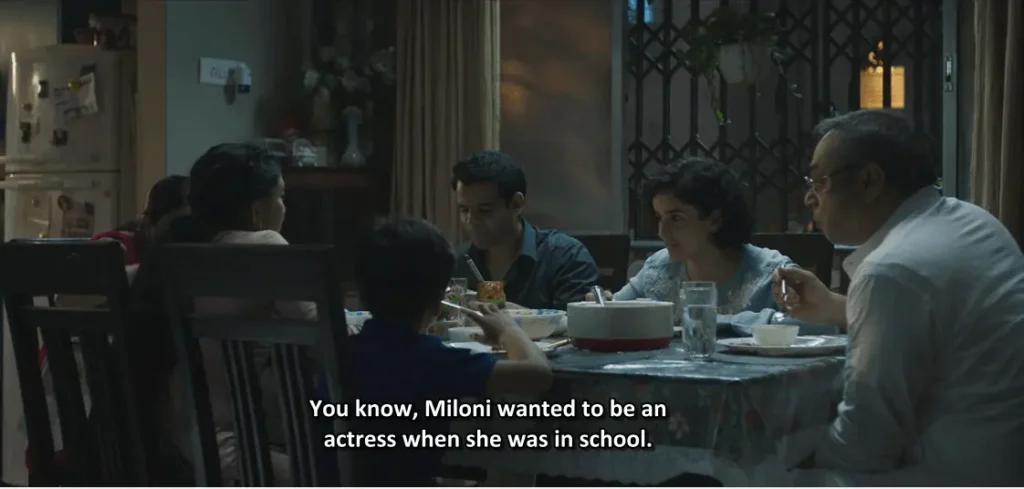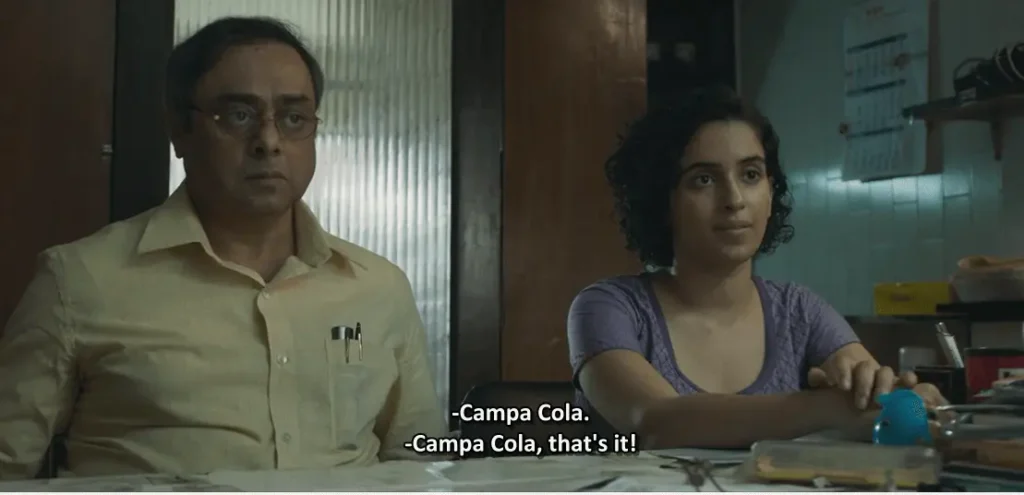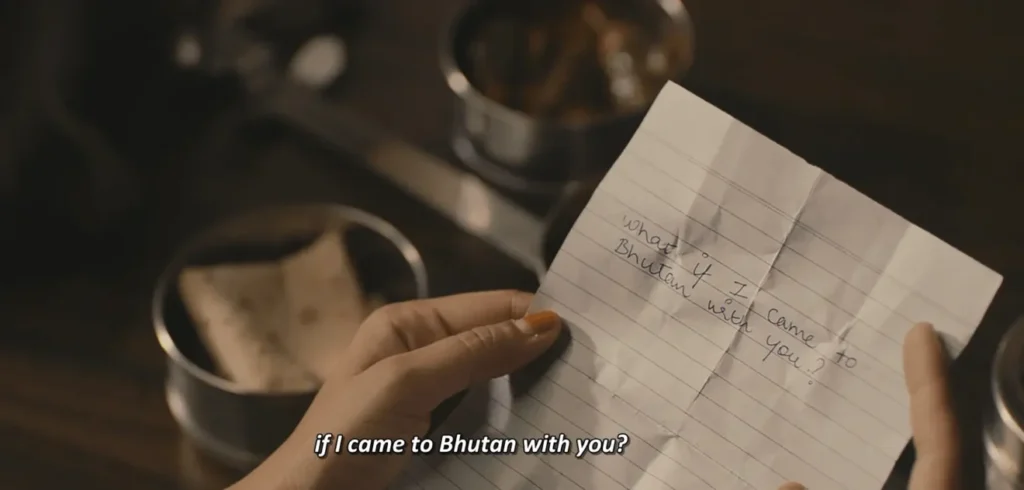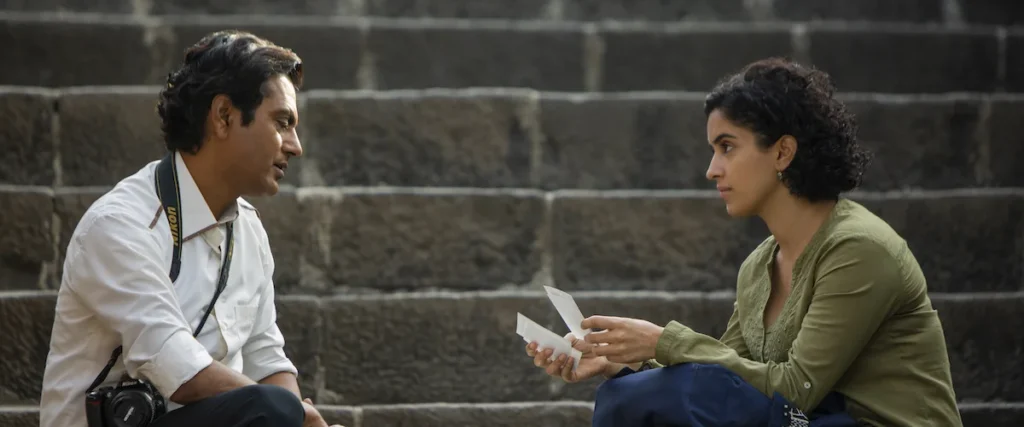Ritesh Batra took 6 years to release his second Hindi film, Photograph, after my favourite film, The Lunchbox. This time he explained the story of two obedient individuals, Miloni (Sanya Malhotra), who is studying to become a chartered accountant, and Rafi (Nawazuddin Siddiqui), a street photographer. Let’s see how Batra crafted a different movie from the same set of characters, elements, and geography that he used in The Lunchbox. In essence, both films are narrating the same crux.
Miloni meets Rafi at the Gateway of India in Mumbai, where she allows him to take her photograph. Unfortunately, her family calls her away before he can give it to her in an envelope. Later, circumstances make Rafi ask Miloni to act as his girlfriend while his grandmother (Farrukh Jaffar) visits. She agrees, leading to the formation of an unexpected connection between them. Nawazuddin Siddiqui and Sanya Malhotra perfectly match the film’s gentle mood, expressing much through subtle body language, the setting, and their eyes.
“Years from now, when you look at this photo, you’ll feel the sun on your face, wind in your hair and hear all these voices again. Or it’ll all be gone. Gone forever.”
– Rafi in Photograph (2019)
Two Parallel Rays From Different Sources
Miloni and Rafi have different backgrounds, yet they are moving in parallel in the same direction. Photograph explained this journey in The Lunchbox style. They both are not sailing in life for what they want; rather, they are living for others. They are obedient people who have followed whatever has been told to them.

Miloni was always obedient to her parent’s choices. There is a scene where, during dinner, her family members say that Miloni wanted to become an actress before her family pushed her to study accounting. and her father is surprised. She wears what her family thinks looks good on her. She doesn’t even have a favourite colour in her life. Miloni conforms to her family’s expectations, donning attire they find appealing.

Similarly, Rafi’s life is dedicated to his family’s well-being. He toils away, shouldering the heavy burden of his village home’s debt and single-handedly covering his sisters’ wedding costs. His unwavering commitment extends to fulfilling his grandmother’s desires without hesitation. His nights remind me of Saajan from The Lunchbox. Both are isolated in their own islands.
Symmetry happens From Asymmetries
The movie describes Rafi & Miloni both living for the sake of their family by killing their smiles; they were on the stage of life where they forgot their smile and were going through a monotonous life. In Rafi’s photographs, Miloni is finding her smile, which she lost in between.
At the post office, while sending off a money order, the clerk gently nudges Rafi to consider his own needs for once, suggesting he keep a little money for himself. “Keep some for yourself too, Rafi Bhai,” she advises. Rafi’s life is a testament to selflessness and familial devotion, painting a portrait of a man who lives not for himself but for the ones he loves.

Miloni and Rafi face similar challenges, though their lives began very differently. Miloni comes from a Hindu, upper-middle-class urban family, while Rafi is Muslim and from a lower-middle-class family. Their differences are stark, not just in their religious backgrounds but also in their skin tones and how they dress.

There are even moments in the film where people comment on Rafi because Miloni looks so different from him. Yet, at their core, they are the same: both are kind, empathetic, and lonely yet surrounded by people. Rafi is like a gulab jamun, and Miloni is like a rasgulla—both are sweet, yet distinct to those around them.
As the relationship between Miloni and Rafi unfolds, Photograph explained their progression from strangers to connected souls.
Being the Slave of Own Past

Miloni seems to live in her past, reminiscing about her childhood. She inquires about farm life from her maid and shares with Rafi her fond memories of drinking Campa Cola with her grandfather. There’s a scene where a doctor remembers her as a young, adventurous lady, visiting with her grandfather, Campa Cola in hand.

Even in a matchmaking scene, when a man asks Miloni where she would like to live, she answers, “A village.” Surprised, he asks her what she would do there. She tells him, “I will do farming in the morning and take a nap in the afternoon“. Rafi, on the other hand, feels stuck due to his duties.
Who Do Not Move, Do Not Notice Their Chains
As their relationship develops, Miloni and Rafi start to move away from their obedient roles towards rebellion, each in their own way. What disappoints me is that, like Batra’s previous film, The Lunchbox, Photograph also ends with an open ending, leaving us wondering what happens next.

In the middle of the movie, when Rafi and Miloni go to a movie theatre, a rat runs over Miloni’s feet, making her uncomfortable. This scene quickly cuts to Miloni’s study table.
Initially, we don’t see what happens after the movie theatre incident. Ritesh Batra saves this crucial scene for the end, where they have a brief chat, Miloni asks him, “Don’t you want to continue the movie?” and Rafi says, “I know the rest of the story. They will fall in love, but because of their backgrounds, they won’t be together.”
The open ending of ‘Photograph,’ explained as a choice by the director The director wants us to follow the story in a linear style until the ending scene. Here, it becomes clear that both Rafi and Miloni understand their backgrounds and social status and that they are unlikely to end up together in this society. After recognising this reality and their probable future, they decide to go with the flow without saying it out loud.
Nostalgia is an Illusion
The story brings back memories with its use of public phone booths and the classic kaali-peeli taxis, even though smartphones and online cab services are common now. It feels like the story was meant for the last decade. Because of this, while the movie becomes nostalgic, it might not seem as relevant today.

I noticed something similar in Sriram Raghavan’s “Merry Christmas.” There is a dialogue in Photograph where a cola factory worker says: “Our country is big, but its memory is short.” But Photograph will definitely make sure to recall your memories.
Photographs are Footprints
Another notable aspect of the film is the frequent focus on characters’ feet, especially Miloni’s. When she feels nervous, the film often shows her feet moving restlessly.

Since Miloni doesn’t share her thoughts out loud and stays quiet, these shots of her feet help show she’s feeling nervous.

It seemed meaningful that the gift Miloni receives from Rafi’s grandmother is a pair of anklets, perhaps suggesting a wish for her to express her feelings more loud.
Parallel World, Parallel Events
The world of Photograph is not different from the one in The Lunchbox. Both films incorporate traditional elements like letters and photographs in an era dominated by text messages and selfies. The main characters exist in a state of isolation amidst the bustling life of Mumbai, where everyone else seems to be in a rush, and they are left hoping for a change.

In both movies, loneliness plays a critical role, almost acting as a character itself. Both stories gradually evolve after an accidental encounter, forming unexpected friendships and ambiguous relationships among the main characters.

A mix-up with a lunchbox initiates a classic letter-writing romance between Ila (Nimrat Kaur) and Saajan (Irrfan Khan) in The Lunchbox. Similarly, a random meeting at the Gateway of India sparks an impromptu romance between Rafi and Miloni. In each story, there is a noticeable age difference between the male and female leads, highlighting their distinct contrasts.
Same Templates, Different Emotions
Ritesh Batra employs familiar cinematic techniques in both The Lunchbox and Photograph. The Lunchbox starts with imagery of two trains moving in opposite directions, while Photograph captures traffic flowing similarly.

Notably, in The Lunchbox, we hear Deshpande Aunty’s voice without seeing her, and only glimpse the exterior of Ila’s father. Similarly, in Photograph, Rafi’s interactions at the post office feature only the voice of the postal worker, whom we never see, yet who seems to know him well and speak like a well-wisher.
Batra’s way of intensifying emotional scenes diverges from the age-old Kurosawa technique of using close-up shots of face gestures. He emphasises voices over facial expressions.
In Photograph, Batra effectively uses auditory elements multiple times. For example, the woman on the bus questioning Miloni about appearing on a billboard for Miloni’s coaching centre remains unseen.

The introduction of Miloni’s teacher delays showing his face until the scene nearly ends. When a potential suitor’s parents visit Miloni, everyone’s face, except Miloni’s is blurred. Additionally, in the scene where Rafi encounters the Campa Cola manufacturer, the factory setting is blurred, focusing on Rafi from behind, while the background sounds and music convey the scene’s essence.
Same Characters, Same Elements
In The Lunchbox, Ila says Deshpande Uncle always stared at the ceiling fan because he thought his life depended on it. Deshpande Aunty bought an inverter to keep the fan on forever. In Photograph, we also see and hear the ceiling fan a lot. Even after the very first scene of Rafi, it cuts to a ceiling fan. The movie shows some scenes as if we are looking down from where the fan is. Tiwari Ji took his own life with the fan.

In The Lunchbox, Saajan writes that he spent his whole life standing in trains and buses, and he will have to stand even when he is dead as there are no horizontal burial plots left and only vertical burial plots are being offered.
In Photograph, you can see a similar viewpoint from Rafi, he complains to Miloni about the hurry-burry of people in Mumbai. Even Batra added a symbol for the rat-race life of Rafi and his friends. The door of Rafi’s house opens upwards, making it feel like he is living in a box.
Even the elements of death and those haunting narrations are similar in The Lunchbox and Photograph. A woman jumps along with her daughter and commits suicide in The Lunchbox; In Photograph, it’s Tiwari ji, who commits suicide by hanging over the ceiling fan. Even there is a scene where Rafi’s friend Zakir comments over Tiwari Ji, “No one gets peace in Mumbai, not even in death”.

Even the utopian dreams of lead characters are nearly the same in The Lunchbox and Photograph. In the Lunchbox, it’s Ila and her desire to move to Bhutan for happiness.

In Photograph it’s Miloni’s desire to live in a village. They are yearning to move out of the cubicle life of bustling cities. Miloni connected more with people who came from villages, whether it was her maid or Rafi.
Photograph: A Pause Button
Even sometimes, I felt that Miloni was an extended version of Ila’s daughter in the Lunchbox. Mostly, Miloni’s character is inert in the movie, which makes it difficult to read her motivations. For instance, Miloni agrees to play Rafi’s girlfriend, but the film never explains her reasons for doing so.

Ritesh Batra beautifully packed Nostalgia or “those good old days,” in every frame of The Lunchbox and Photograph. The Lunchbox depicted old TV shows, radio shows, video cassettes, and letters. Photograph shows Campa Cola, softies, kulfi, kaali-peeli taxis, money orders, old theatres, and post offices.
“I think we forget things if we have no one to tell them to,”
Saajan (The Lunchbox)
Perhaps this is the reason Ritesh Batra includes such nostalgic elements in his movies. By doing so, he leads us down a path where we too revisit our own childhood memories alongside him. Nostalgia becomes even more delightful when we have someone to share those memories with and look back on the times that will never return.